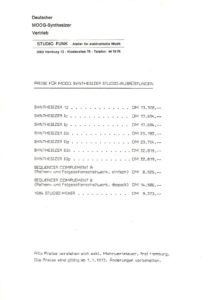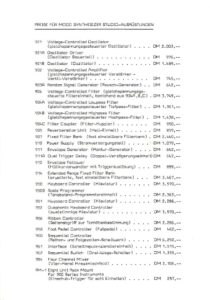Archives: Februar 2018
2018 26 Feb
Caetano Veloso: Caetano Veloso (1968)
Manafonistas | Filed under: Blog | RSS 2.0 | TB | 1 Comment
The cover is bonkers, but who cares? Caetano Veloso’s first album as a solo artist marked the birth of the culturally revolutionary tropicalia movement. The concept of the movement was to modernize Brazilian popular culture and, through creative music and poetry, reflect the Brazilian society as it appeared at the time. This kind of wild cultural and musical cannibalism was found to be very controversial by many elements of the Brazilian society, both to the left and to the right of the political spectrum, and would ultimately lead to the arrest and forced exile in 1969. But at look at the album from today’s perspective: This debut was a unique 12-track gem. In retrospect Caetano called it „amateurish and confused“, but artists are not always the best critics of their own works. Confusion, maybe as a gateway to the new. In addition to the often bewildering nature and uniquely inventive music on the album, what strikes the listener is the excellent standard of the lyrics. More often than not, the lyrics could easily stand alone as poems. For all its artistic quality, and its position as the first tropicalia album, this is a classic and one of the most important albums of Brazilian popular music history. Now we have 2019, and the new government sings its praise of the old era of Brazilian fascism. The new fascists seek for new brothers in the world, and one of their first allies became the repressive government of Israel’s Netanjahu. Very often artists thought that Brazil would be the future. A big illusion, this future only arrived once, in the early years of Tropicalia. You got it, the future was a dream. On his debut Caetano was firing on all cylinders. Except, he‘s not rock’n’rolling the boat. Years ago, the album had got its remastered cd version, now (at least) a first reissue on vinyl on „Third Man Records“ is ready for release.
(remixed from four different sources)
2018 24 Feb
„That‘s All, Folks!“
Michael Engelbrecht | Filed under: Blog | RSS 2.0 | TB | 7 Comments
Wir wussten, dass in Deutschland Zauberer unterwegs waren, manche hatten magische Pilze, andere makriobotische Ernährung im Repertoire. Bei der Volksmusik konnten sie nicht fündig werden, die Eltern sprachen von Hottentottenmusik, und die von ihrer Nazizeit Heimgesuchten fanden kleine Fluchten in Bella Italia, in deutschen Schlagern – und Fleischfondues incl. Diashows und James Last. Deutschland wollte ja wieder unschuldig werden und wählte die Regressionen, die schlechter Geschmack und gut gefüllte Geldbeutel eben möglich machen.
Mit vertrauten und fast vergessenen Magiern der „Deutschen Elektronischen Musik“ hat Soul Jazz Records jetzt eine dritte Kompilation rausgebracht, zwei CDs, drei Vinylscheiben. Krautrocker, Sphärenforscher, Trancegroover – die Palette der Jahre 1971 bis 1981 war ein üppiger Strauss der Vielfältigkeiten. Zu entdecken gibt es wohl immer noch so einiges. Vieles wurde durch die Zeit an den Rand gedrängt, dabei hält der Underground jener Jahre immer noch wilde, weissgott nicht nur wohlige, Schauer parat.
Und so driftet man durch allerlei Welten hier, zwischen willkommenen „Dejavus“ und augenreibenden „Was-ist-das-denn-Momenten“. Ich gestehe, mehr als ein breites Honigkuchengrinsen fiel mir nicht ein, als ich, im Laufe dieser zwei Stunden (am Stück im Dunkeln gehört, mit Kiff, Ananas und Kerzenschein) zwei lange Tracks des fantastischen Michael Bundt entdeckte. Ich kannte nicht mal den Namen. Stuart Baker liess im übrigen, als die Archäologen im Londoner Hauptquartier den letzten Staub aus den Regalen gefegt hatten, seine Designabteilung wissen, das sei nun nicht mehr zu steigern, und sie mögen auf das geplante Cover noch einen Untertitel platzieren: „That‘s All, Folks!“
(aus dem Manuskript für die Radionacht Klanghorizonte, dritter Samstag im April, „Kiff“ wird durch „Kakao“ ersetzt).
Some months ago, a friend asked me about the best-sounding jazz album ever. What a question, I answered. I don‘t know anything about „ever“, but ask me about a certain time. Then he asked me about the best-sounding jazz album of my teenager years, and the best-sounding album „before my time“. Okay, choices made instantly. I said, „Dis“ with Jan Garbarek, Ralph Towner, and the short appearances of a wind harp.
And thinking of the times before my time, I said, „Way Out West“. It was made in the middle of the night on March 7, 1957, in the shipping room of a small Los Angeles record company, with an underpaid engineer recording a trio playing cowboy songs on a first-generation stereo Ampex tape deck through a homemade mixing console. It seems an unlikely setting for one of the greatest jazz recordings of all time, musically and sonically.
But the players were Sonny Rollins and Ray Brown and Shelly Manne, and, on that night, they were cookin’. What seems like strange duo of vinyl albums, makes some extra sense when realizing a strong bond between them: deep relaxation, high intensity, breathing space. Real favourites.
Now, with some studio chatter and unreleased versions, a double vinyl edition of Sonny Rollins’ classic has been published. You don‘t need to have that one, a single vinyl edition is enough to induce addictive deep listening. The sound is dry, but vibrant, the channel separation has its own aura, far away from being one of these minor quibbles in regards of the limitations of early stereo. Come on. It‘s a cracker. Joyful and deep. I was enthusiastic when I spoke about it during a talk with Norwegian master bass player Arild Andersen years ago. He had never heard it, just knew about its existence. Now, finally, he has it at home, and has one word for it: GREAT.
2018 23 Feb
Gregor öffnet seinen Plattenschrank (157)
Gregor Mundt | Filed under: Blog | RSS 2.0 | TB | Tags: Hannover | 3 Comments
Er war gerade sechs Jahre alt geworden, als er zum ersten Mal allein in die Innenstadt fahren durfte. Zunächst galt es zur Straßenbahnhaltestelle zu schlendern und dann zu hoffen, dass eine alte Straßenbahn kommen möge, die mit den Holzsitzen und der langen Lederschnur unter dem Straßenbahndach, an dem der Schaffner kräftig ziehen musste, um ein schrilles Läuten auszulösen, was dem Fahrer bedeutete, dass er nun abfahren durfte. Diese alten Bahnen, die 1959 manchmal noch durch Hannover fuhren, hatte er ins Herz geschlossen. Und tatsächlich, an diesem Tag kam die betagte Bahn mit der Nummer 5. Er kaufte beim Schaffner eine Kinderfahrkarte und los ging es bis zum Aegidientorplatz. Dort führte sein Weg zunächst zu einer Filiale der Firma MOST. Bis 1999 konnte man bei MOST edle Süßigkeiten kaufen, Ende der fünfziger Jahre, da gab es die Firma schon 100Jahre, bekam man zumindest hier in der hannoverschen Filiale für ein paar Groschen ein große Tüte Süßigkeiten-Bruch. Weiter führte der Weg des Jungen an den Mercedes-Benz-Ausstellungsräumen vorbei, magisch angezogen von den wunderschönen Autos, konnte er sich von den Schaufenbstern kaum lösen. Dann am Theater-Am-Aegi entlang – das Theater sollte 1964 in Flammen aufgehen und ein riesiges schwarzen Loch hinterlassen, was den Jungen stets in Schrecken versetzte – in die Maschstraße. Hier gab es nicht viel Interessantes zu schauen, außerdem war diese uninteressante Straße auch noch sehr lang, bis sie dann schließlich in die Meterstraße mündete. Hier, auf dem Gelände einer Schule waren die Übungsräume des Knabenchor Hannover, dem der Junge nun angehören sollte, untergebracht. Er hat das Singen im Chor gemocht, sehr sogar, aber die Fahrt und der Weg dorthin und wieder zurück, nach Hause, das war für ihn einfach nur großartig und er freute sich immer darauf, allein unterwegs zu sein.
Jahrzehnte ist das her, aber sein weiteres Leben hat der ehemalige Chorknabe seinen Knacbenchor Hannover niemals aus dem Blick verloren. An zahlreichen Veröffentlichungen hat er sich über all die Jahre erfreut, aber 2017 wurde er besonders hellhörig, da hat der Knabenchor Hannover eine ganz ungewöhnliche CD herausgebracht: ”New Eyes on Martin Luther” mit Jeanette Köhn, Nils Landgren, Magnus Lindgren, Eva Kruse, Johan Norberg, Knabenchor Hannover und Capella de la Torre . Jörg Breiding leitet inzwischen den Chor und er hatte während des Projektes ”New Eyes on Martin Luther” auch die Aufgabe, so unterschiedliche Ensembles musikalisch zusammenzuführen; also das von Katharina Bäuml an der Schalmei geleitete Capella de la Torre, die Gruppe Nils Landgren and Friends und schließlich seinen eigenen Chor. Der NDR hat das Konzert in Hannover mitgeschnitten und auf Act-Records veröffentlicht. Herausgekommen ist eine großartige Platte. ACT-Music schreibt auf seiner Produkt-Info-Seite u.a.: „The three ensembles just dived into the music without pre-conceptions. The traditional German folksong “Die Gedanken sind frei” is here performed with a percussive flute solo, and Landgren’s smooth voice on top of a funky rhythm. Sometimes he joins Capella de la Torre with a trombone solo and when all musicians play together it sounds as if the music was originally written with this in mind. It moves seamlessly between genres and what you can hear is the sound of really skilled musicians together – and just having fun.“

2018 22 Feb
The return of Twin Peaks
Michael Engelbrecht | Filed under: Blog | RSS 2.0 | TB | 1 Comment
The most exhilirating of my recent time travel activities has been the return of „Twin Peaks“, 25 years after leaving Agent Cooper in a disturbing trap. 18 episodes rush over you with the inventiveness of radical cinema, anti-nostalgia (what an ability to disappoint our expectations – and then to fulfill at least some of them when we are all ready to give up) – and an even higher level of bleakness that can only be handled with a big step into surrealism, dream territories, and some fleeting moments of relief.
Though I always raise my eyebrows when David Lynch promotes his heavily manipulative TM machinery (as bad as Scientology), he is definitely still a master in filmmaking, a chain-smoker, and (looking at the bonus material) apparently a warm-hearted person (sometimes:)).
It takes some time to discover old traces of humour and burlesque again, but they still exist. As does a prevailing sense of wonder. This is enlightening stuff from the department of darkness, and more so for those who have seen the first two seasons decades ago. A show that once changed the landscape of television forever – ask Damon Lindelof, the mastermind of LOST and THE LEFTOVERS. Or, simply remember.
And, please, forget your dreams of fairytale endings. In essence, it is all about the samsara of life, the illlusionary character of everything we are striving for with blindness (to only offer you the polite version). We learn these things with a devastating sense of hopelessness. David Lynch wanted us to feel utterly lost. It’s one of the most powerful emotions there is. What a paradox that in the end you are left speechless, but with a strangely knowing smile.
And the humans here, coming back from the glorious past of early Twin Peaks – some of them have had to face their deaths in fucking real life, after the curtain call. The old lucid dreamer‘s question about being in a dream or in waking life, you can ask this the whole way through. David Lynch looks at „The Return“ as a long movie, and was getting some angry responses by the same fools who thought Bob Dylan should never have come even near winning his Nobel prize. Trapped in classification. „Twin Peaks – The Return“ is a masterpiece – and its ways of delivering sound, song and noise add to the magic. By the way, the extras on disc 8 are the icing on the dark cake.
2018 20 Feb
for bess on a northern shore
Manafonistas | Filed under: Blog | RSS 2.0 | TB | 7 Comments
not for reason mixed with treason
not for all these beloved seasons (darling buds of may)
(the dust department has been closed recently)
no matter what john d. and ross macdonald might add
or subtract and subvert
i am fighting for the first daylight
of all your tomorrow mornings
(i would even paint the dawn)





